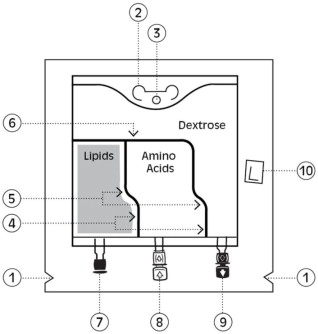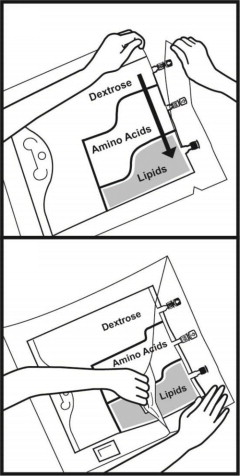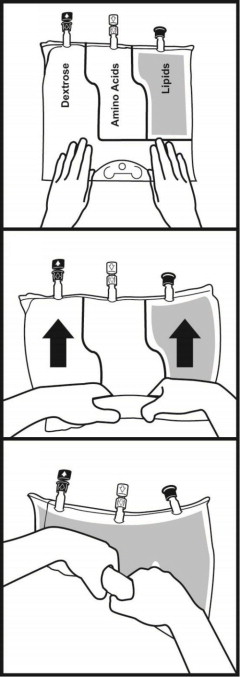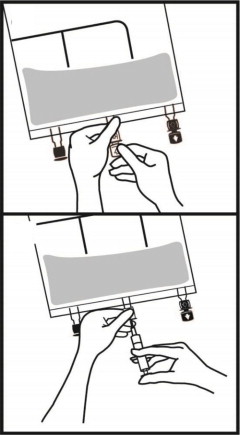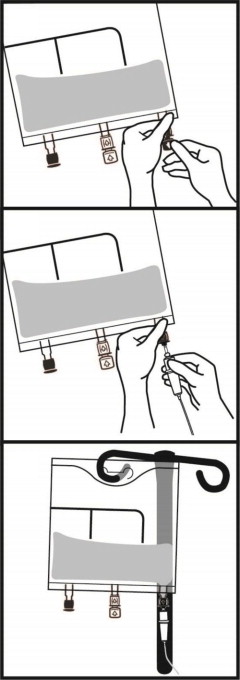Kabiven Dosage
Generic name: DEXTROSE MONOHYDRATE 10.8g in 100mL, SOYBEAN OIL 3.9g in 100mL, SODIUM ACETATE 239mg in 100mL, POTASSIUM CHLORIDE 174mg in 100mL, SODIUM GLYCEROPHOSPHATE ANHYDROUS 147mg in 100mL, MAGNESIUM SULFATE HEPTAHYDRATE 96mg in 100mL, CALCIUM CHLORIDE 29mg in 100mL, LYSINE HYDROCHLORIDE 263mg in 100mL, PHENYLALANINE 231mg in 100mL, LEUCINE 231mg in 100mL, VALINE 213mg in 100mL, HISTIDINE 199mg in 100mL, THREONINE 164mg in 100mL, METHIONINE 164mg in 100mL, ISOLEUCINE 164mg in 100mL, TRYPTOPHAN 55mg in 100mL, ALANINE 467mg in 100mL, ARGININE 330mg in 100mL, GLYCINE 231mg in 100mL, PROLINE 199mg in 100mL, GLUTAMIC ACID 164mg in 100mL, SERINE 131mg in 100mL, ASPARTIC ACID 99mg in 100mL, TYROSINE 6.7mg in 100mL
Dosage form: injectable emulsion
Drug class: Intravenous nutritional products
Medically reviewed by Drugs.com. Last updated on Jul 23, 2025.
2.1 Administration
- KABIVEN is for intravenous infusion only into a central vein.
- Use a 1.2 micron in-line filter.
- Use of a vented intravenous administration set with the vent in the open position could result in air embolism.
- Use a dedicated line without any connections. Multiple connections could result in air embolism due to residual air being drawn from the primary container before administration of the fluid from the secondary container is completed.
- Do not exceed the recommended maximum infusion rate of 2.6 mL/kg/hour.
- Ceftriaxone must not be administered simultaneously with calcium-containing intravenous solutions such as KABIVEN via a Y-site due to precipitation. However, in patients other than neonates, ceftriaxone and KABIVEN may be administered sequentially if the infusion lines are thoroughly flushed between infusions with a compatible fluid.
- Do not use administration sets and lines that contain di-2-ethylhexyl phthalate (DEHP). Administration sets that contain polyvinyl chloride (PVC) components have DEHP as a plasticizer.
Important Preparation Instructions
- Inspect the bag prior to activation. Discard the bag in the following situations:
- Evidence of damage to the bag
- More than one chamber is white
- Solution is yellow
- Any seal is already broken
- Activate the bag.
- Once the bag is activated, ensure the vertical seals between chambers are broken at least from the bend in the seals and down to the ports. The upper sections of the vertical seals above the bend and the horizontal seal may remain closed.
- It is recommended to mix the contents thoroughly by inverting the bag upside down to ensure a homogenous admixture.
- Ensure the vertical seals between chambers are broken and the contents of all three chambers are mixed together prior to infusion.
- Use KABIVEN immediately after the introduction of additives. If not used immediately, the storage time and conditions prior to use should not be longer than 24 hours at 2° to 8°C (36° to 46°F). After removal from storage at 2° to 8°C (36° to 46°F), the admixture should be infused within 24 hours. Any mixture remaining must be discarded.
- In the absence of additives, once activated, KABIVEN remains stable for 48 hours at 25°C (77°F). If not used immediately, the activated bag can be stored for up to 7 days under refrigeration [2° to 8°C (36º to 46°F)]. After removal from refrigeration, the activated bag should be used within 48 hours.
- For total parenteral nutrition add multivitamins and trace elements via the additive port. Any other additions to the bag should be evaluated by a pharmacist for compatibility. Questions about compatibility may be directed to Fresenius Kabi USA, LLC.
- When introducing additives, it is recommended to use 18 to 23 gauge needles with a maximum length of 1.5 inches (40 mm) and to mix thoroughly after each addition, use aseptic technique and add after the vertical seals have been broken (i.e. bag has been activated) and the three components are mixed.
- Parenteral drug products should be inspected visually for particulate matter and discoloration prior to administration, whenever solution and container permit. Inspect KABIVEN to ensure:
- Precipitates have not formed during the mixing or addition of additives.
- The emulsion has not separated. Separation of the emulsion can be visibly identified by a yellowish streaking or the accumulation of yellowish droplets in the mixed emulsion.
Discard the admixture if any of the above are observed.
Instructions for Use
Dosing Considerations
The dosage of KABIVEN should be individualized based on the patient's clinical condition (ability to adequately metabolize amino acids, dextrose and lipids), body weight and nutritional/fluid requirements, as well as additional energy given orally/enterally to the patient.
KABIVEN is a combination of amino acids, electrolytes, dextrose, and lipids in a fixed volume and concentration. The dosage selection is based upon fluid requirements which can be used in conjunction with the nutritional requirements to determine final dosage. KABIVEN meets the total nutritional requirements for protein, dextrose and lipids in stable patients, and can be individualized to meet specific needs with the addition of nutrients. The maximum infusion rate is based upon the dextrose component.
Prior to administration of KABIVEN, correct severe fluid, electrolyte and acid-base disorders. Before starting the infusion, obtain serum triglyceride levels to establish the baseline value.
Recommended Adult Dosage
The recommended dosage of KABIVEN in adults is 19 to 38 mL/kg/day. The amount of macronutrients provided by KABIVEN are shown in Table 1.
The maximum daily dosage of KABIVEN in adults should not exceed 40 mL/kg/day.
In patients with serum triglyceride concentrations above 400 mg/dL, stop the KABIVEN infusion and monitor serum triglyceride levels. Once the triglycerides are <400 mg/dL, restart KABIVEN at a lower infusion rate and advance rate in smaller increments towards target dosage, checking the triglyceride levels prior to each adjustment.
|
* Protein is provided as amino acids. When infused intravenously amino acids are metabolized and utilized as the building blocks of protein. |
|
|
** As Dextrose monohydrate |
|
| Nutrition Provided by KABIVEN recommended dosage | |
| Fluid mL/kg/day | 19 to 38 |
| Protein* g/kg/day Nitrogen g/kg/day |
0.6 to 1.3 0.1 to 0.2 |
| Dextrose** g/kg/day | 2.1 to 4.1 |
| Lipids g/kg/day | 0.7 to 1.5 |
| Total Energy Requirement kcal/kg/day | 16 to 32 |
Treatment with KABIVEN may be continued for as long as is required by the patient's condition.
Dosing in Renal Impairment
In patients with renal impairment, the dosage of KABIVEN should be the recommended adult dosage (see above). Prior to administration, correct severe fluid or electrolyte imbalances. Closely monitor serum electrolyte levels and adjust the volume of KABIVEN administered as required.
Renal patients not needing dialysis require 0.6 to 0.8 g of protein/kg/day. Patients on dialysis or continuous renal replacement therapy should receive 1.2 to 1.8 g of protein/kg/day up to a maximum of 2.5 g of protein/kg/day based on nutritional status and estimated protein losses. The KABIVEN dosage can be adjusted based on the treatment for the renal impairment, supplementing protein as indicated. If required, additional amino acids may be added to the KABIVEN bag or infused separately.
Infusion Duration and Rate
The recommended duration of infusion for KABIVEN is between 12 and 24 hours, depending on the clinical situation.
The maximum infusion rate of KABIVEN is 2.6 mL/kg/hour. This corresponds to 0.09 g/kg/hour of amino acids, 0.28 g/kg/hour of dextrose (the rate limiting factor) and 0.1 g/kg/hour of lipids.
Dosing Instructions
- Determine the fluid requirements (19 to 38 mL/kg/day) and the patient's nutritional requirements to be delivered, and then select the corresponding KABIVEN bag.
- Determine the preferred duration of infusion (12 to 24 hours).
- Ensure that the rate of infusion (KABIVEN dosage in mL/kg/day divided by the preferred duration of infusion (hours)) does not exceed the maximum infusion rate for the patient (i.e., 2.6 mL/kg/hour). The infusion rate may need to be reduced and duration of infusion increased in order not to exceed the maximum infusion rate.
- Once the infusion rate in mL/kg/hour has been selected, calculate the infusion rate (mL/hour) using the patient's weight.
- Compare the patient's nutrient requirements with the amount supplied by KABIVEN. Discuss with a pharmacist any additions that may be required.
More about Kabiven (parenteral nutrition solution w/electrolytes)
- Check interactions
- Compare alternatives
- Pricing & coupons
- Side effects
- FDA approval history
- Drug class: intravenous nutritional products
Patient resources
Other brands
Professional resources
Other brands
Related treatment guides
See also:
Further information
Always consult your healthcare provider to ensure the information displayed on this page applies to your personal circumstances.

